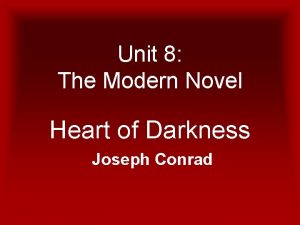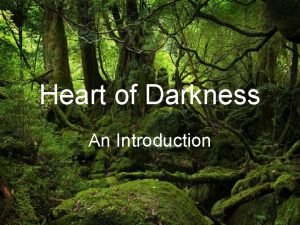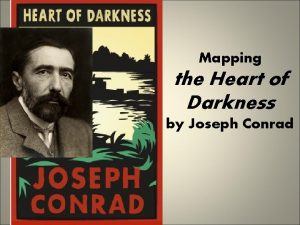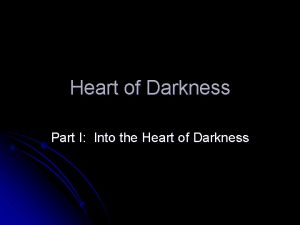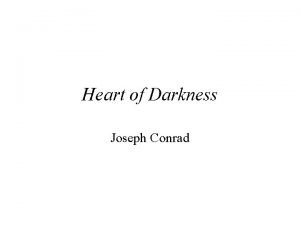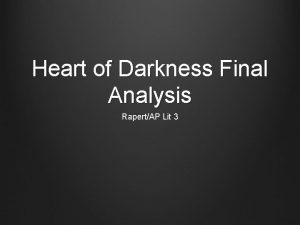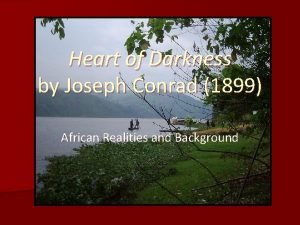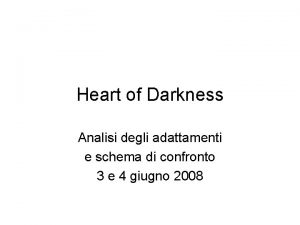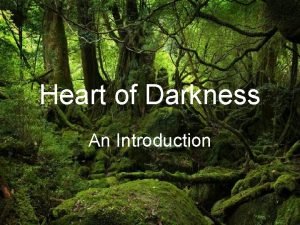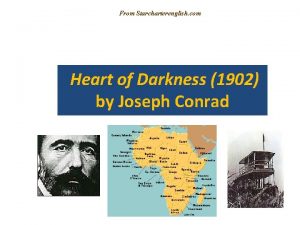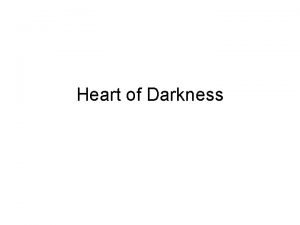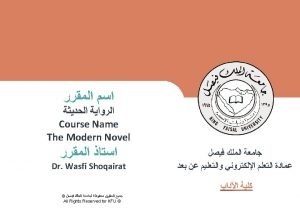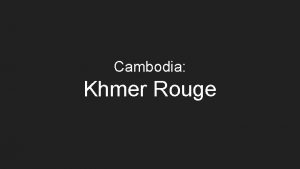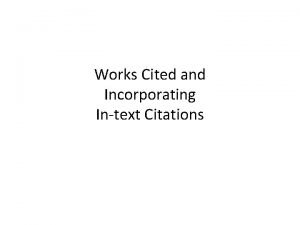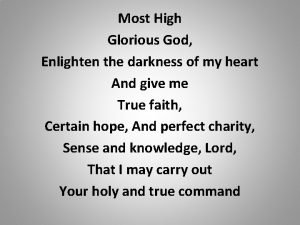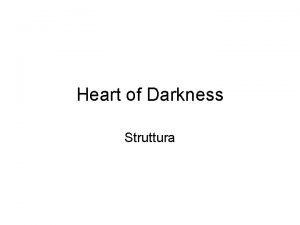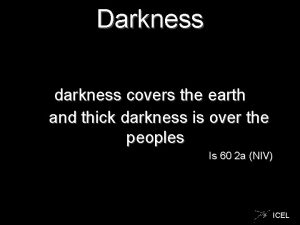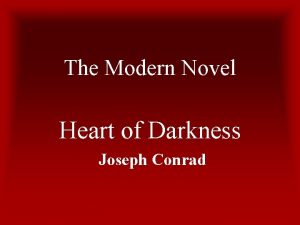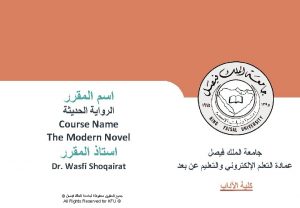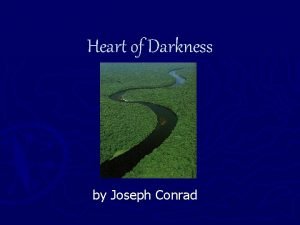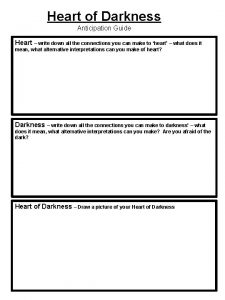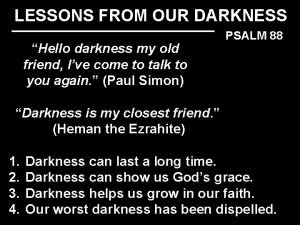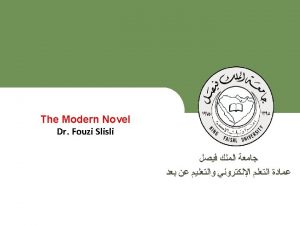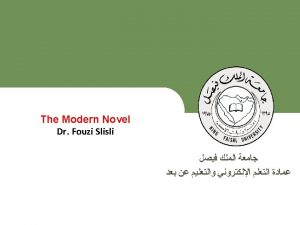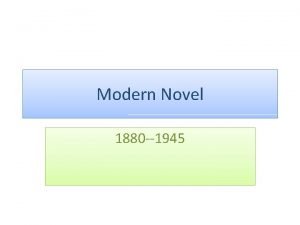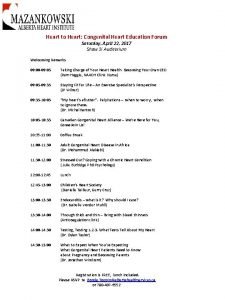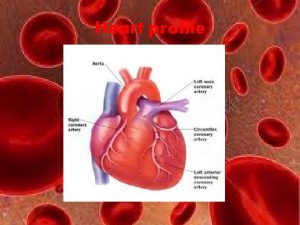Unit 8 The Modern Novel Heart of Darkness
















- Slides: 16

Unit 8: The Modern Novel Heart of Darkness Joseph Conrad

Major Characters • Marlow - The protagonist of Heart of Darkness. • Kurtz - The chief of the Inner Station and the object of Marlow’s quest. • General manager - The chief agent of the Company in its African territory, who runs the Central Station. • Brick maker - The brick maker, whom Marlow also meets at the Central Station, is a favorite of the manager and seems to be a kind of corporate spy. • Chief accountant - An efficient worker with an incredible habit of dressing up in spotless whites and keeping himself absolutely tidy despite the squalor and heat of the Outer Station, where he lives and works.

Minor Characters • Pilgrims - The bumbling, greedy agents of the Central Station. • Cannibals - They all want to be appointed to a station so that they can trade for ivory and earn a commission, but none of them actually takes any effective steps toward achieving this goal. • Russian trader - A Russian sailor who has gone into the African interior as the trading representative of a Dutch company. • Kurtz’s African Mistress - A fiercely beautiful woman loaded with jewelry who appears on the shore when Marlow’s steamer arrives at and leaves the Inner Station.

Minor Characters Con’t • Kurtz’s Intended - Kurtz’s naïve and long-suffering fiancée, whom Marlow goes to visit after Kurtz’s death. • Aunt - Marlow’s doting relative, who secures him a position with the Company • The men aboard the Nellie - Marlow’s friends, who are with him aboard a ship on the Thames at the story’s opening. They are the audience for the central story of Heart of Darkness, which Marlow narrates. • Fresleven - Marlow’s predecessor as captain of the steamer.

Themes • The Hypocrisy of Imperialism – i. e. As Marlow travels from the Outer Station to the Central Station and finally up the river to the Inner Station, he encounters scenes of torture, cruelty, and near-slavery. At the very least, the incidental scenery of the book offers a harsh picture of colonial enterprise. • Madness as a result of Imperialism – Madness has two primary functions. it serves as an ironic device to engage the reader’s sympathies. Also functions to establish the necessity of social fictions. • Absurdity of Evil – explodes the idea of the proverbial choice between the lesser of two evils. As the idealistic Marlow is forced to align himself with either the hypocritical and malicious colonial bureaucracy or the openly malevolent, rule-defying Kurtz, it becomes increasingly clear that to try to judge either alternative is an act of folly: how can moral standards or social values be relevant in judging evil? Is there such thing as insanity in a world that has already gone insane?

Motifs • Observation and Eavesdropping - Marlow gains a great deal of information by watching the world around him and by overhearing others’ conversations, as when he listens from the deck of the wrecked steamer to the manager of the Central Station and his uncle discussing Kurtz and the Russian trader. • Interiors and Exteriors - Marlow is more interested in surfaces, in the surrounding aura of a thing rather than in any hidden nugget of meaning deep within the thing itself. This inverts the usual hierarchy of meaning: normally one seeks the deep message or hidden truth. • Darkness – it is difficult to discern exactly what it might mean, given that absolutely everything in the book is cloaked in darkness.

Symbols • Fog - Fog not only obscures but distorts: it gives one just enough information to begin making decisions but no way to judge the accuracy of that information, which often ends up being wrong. • The “Whited Sepulchre” - The “whited sepulchre” is probably Brussels, where the Company’s headquarters are located. A sepulchre implies death and confinement. • Women - Kurtz’s Intended and his African mistress function as blank slates upon which the values and the wealth of their respective societies can be displayed. • River - The Congo River is the key to Africa for Europeans. It allows them access to the center of the continent without having to physically cross it; in other words, it allows the white man to remain always separate or outside.

Historical Approach • What specific historical events were happening when the work was being composed? (See timelines in history or literature texts. ) • What historical events does the work deal with? • In what ways did history affect the writer's outlook? • In what ways did history affect the style? language? content? • In what ways and for what reasons did the writer alter historical events? • HOD Criticism : Decrying Joseph Conrad as "a bloody racist", Achebe asserted that Conrad's famous novel dehumanizes Africans, rendering Africa as "a metaphysical battlefield devoid of all recognizable humanity, into which the wandering European enters at his peril. "

Cultural Perspective • What Cultural facts has the author used in the text? • What Cultural facts has the author changed? Why? • What insights do we acquire about the author’s life and culture by reading the text? • How do these facts and insights increase (or diminish) our understanding of the text? • In what ways does the author seem to consider his or her own cultural beliefs as "typical" or significant • Conrad did criticize Culture and Imperialism, but added: "As a creature of his time, Conrad could not grant the natives their freedom, despite his severe critique of the imperialism that enslaved them” – Chinua Achebe

Biographical Approach • What biographical facts has the author used in the text? • What biographical facts has the author changed? Why? • What insights do we acquire about the author’s life by reading the text? • How do these facts and insights increase (or diminish) our understanding of the text? • In what ways does the author seem to consider his or her own life as "typical" or significant

Geographical Approach • Which geographical features in the text are actual? • What aspects of the geography are essential to the story? And which are nonessential? • To what extent has the geography limited the kind of story that can happen? • In what ways has the writer altered the geography to suit his or her purposes? Has the writer made any geographical errors?

Political Approach • What political events are significant in the text? • What political events were occurring at the time the text was written? (See timelines in history or literature texts. ) • What political events were occurring at the time the text was written? • What political beliefs does the author seem to have? And how are those beliefs shown? • What political beliefs does the author seem to dislike? How can you tell?

Religious Perspective • What religious or ethical beliefs does the text deal with directly? Are any religions or philosophies mentioned specifically in the text? • What religious or ethical beliefs or philosophies does the author seem to favor? How can you tell? • What religious or ethical beliefs or philosophies does the author seem to disfavor? How can you tell? • What behaviors do the characters display that the author wants us to think are “right”? How can you tell? • What behavior is “wrong”? How can you tell?

Sociological Approach • What sort of society does the author describe? (How is it set up? What rules are there? What happens to people who break them? Who enforces the rules? ) • What does the writer seem to like or dislike about this society? • What changes do you think the writer would like to make in the society? And how can you tell? • What sorts of pressures does the society put on its members? How do the members respond to this pressure?

Psychological Approach • Are there any specific psychologists or psychological theories mentioned in the text? In what ways? • What theories of human behavior does the writer seem to believe? How can you tell? • What theories of human behavior does the writer seem to reject? How can you tell? • How do people’s minds work in the text? How do people think? How are their thoughts shown? • In what ways do the structure and organization of the text indicate the writer’s beliefs about the workings of the mind?

Applying Concepts • Write a paragraph about Heart of Darkness using one of the previously mentioned analytically approaches.
 Heart of darkness as a modern novel
Heart of darkness as a modern novel Modernism in heart of darkness
Modernism in heart of darkness Marlow's journey in heart of darkness map
Marlow's journey in heart of darkness map Heart of darkness themes and symbols
Heart of darkness themes and symbols Heart of darkness deaths
Heart of darkness deaths Plot summary of heart of darkness
Plot summary of heart of darkness Heart of darkness deaths
Heart of darkness deaths Heart of darkness 1899
Heart of darkness 1899 Heart of darkness analisi
Heart of darkness analisi Heart of darkness historical context
Heart of darkness historical context Themes of heart of darkness
Themes of heart of darkness Heart of darkness pages
Heart of darkness pages Heart of darkness summary part 2
Heart of darkness summary part 2 Heart of darkness cambodia
Heart of darkness cambodia Heart of darkness mla citation
Heart of darkness mla citation Oh most high and glorious god
Oh most high and glorious god Tim roth heart of darkness
Tim roth heart of darkness
